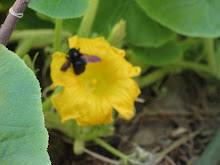Home made Herb Tea Mix
Last evening after the kids were to bed my darling came in searching the cupboard....
Asked I, what he was trying to find?
"The tea pot said he...lets have a pot of tea."
GLEE!!!!!!!!
A pot of tea with the man I love.
JOY!
Late evening so I mixed a sleepy time type concoction
Peppermint (Mentha piperita ), a popular flavoring for gum, toothpaste, and tea, is also used to soothe an upset stomach or to aid in digestion. Because it has a calming and numbing effect, it has been used to treat headaches, skin irritations, anxiety associated with depression, nausea, diarrhea, menstrual cramps, and flatulence. It is also an ingredient in chest rubs, used to treat symptoms of the common cold. In test tubes, peppermint kills some types of bacteria and viruses, suggesting it may have antibacterial and antiviral properties.
Fever Few 1/4 parts
Feverfew (Tanacetum parthenium ), a member of the sunflower family, has been used for centuries in European folk medicine as a remedy for headaches, arthritis, and fevers. The term feverfew is adapted from the Latin word febrifugia or "fever reducer."
Feverfew is also used to treat menstrual irregularities, labor difficulties, skin conditions, stomach aches, and asthma.
Migraine Headaches
Feverfew gained popularity in Great Britain in the 1980s as an alternative to conventional medications for migraine headaches. A survey of 270 migraine sufferers in Great Britain revealed that more than 70% of individuals felt substantially better after ingesting an average of 2 - 3 fresh feverfew leaves daily. Several controlled human trials have been conducted using feverfew for migraine prevention and treatment. Overall, these studies suggest that feverfew taken daily as dried leaf capsules may reduce the incidence of attacks in patients who experience long-term migraine headaches.
- A clinical study used a combination of feverfew with Salix alba (white willow). White willow contains components similar to aspirin. The product was given twice daily for 12 weeks. The frequency of migraine attacks and the pain intensity and duration were significantly reduced in patients taking the combination.
- Another study found that a carbon dioxide extract of feverfew decreased the frequency of migraine attacks from 4.76 per month to 1.9 per month. A 3 month study in 49 subjects found that a combination of feverfew with magnesium and vitamin B2 provided a 50% decrease in migraine attacks.
- Some studies in humans have not been positive. Whether feverfew helps improve migraine pain depends on which feverfew supplement you take. Talk to your health care provider.
Arthritis
Although many laboratory tests and case reports demonstrate anti-inflammatory properties of feverfew, a human study concluded that feverfew was no more effective than placebo in improving symptoms of rheumatoid arthritis. Until further studies are conducted, it appears that the safety and effectiveness of feverfew in people with osteoarthritis or rheumatoid arthritis has yet to be scientifically proven.
Comfrey 1/4 parts
Comfrey has been known for centuries as a priceless herb for wounds, sprains, bruises, and even broken bones in both people and other animals. Farmers have long fed comfrey to their livestock for various ailments or as a spring tonic after a long winter of standing in the typical barnyard mire beneath overcast skies. Farmers have also fed comfrey to their families as a nearly unparalleled source of protein, potassium, calcium, and vitamins A, B12, and C. To that end, it can be eaten in salads, sauteed along with other vegetables, or drunk as a comforting tea.
While comfrey has finally gained some acceptance from the “official” medical community, there is also a quite a bit of fear surrounding the consumption of comfrey. Recently, the FDA banned comfrey from all commercially produced herbal supplements. Bear in mind that the FDA decided to ban the plant only after injecting unnaturally large amounts of the plant's inherent alkaloids into animal test subjects, which then died of liver failure, just as they would have had the alkaloids been extracted from a carrot, concentrated, and injected into their bloodstreams. If nothing else, know that under no circumstances should a pregnant or nursing woman ingest comfrey. That's a commandment that should be heeded and taken seriously for many herbs. Consider yourself fairly warned in the name of science.
Fortunately, it is not necessary to ingest comfrey to reap its greatest medicinal benefits. Used externally, comfrey is completely safe, even for babies, and it is in its use as a wound dressing that comfrey's magic shines through. The next time you get a wound, sprain your ankle, burn yourself, or even break a bone, turn to comfrey for comfort. Of course, if you break your bone or get a serious burn, you'll want to head to the doctor right away, but as was mentioned before, even doctors are often forced to admit comfrey's power to speed the healing process. Comfrey's success as a healing agent is due to allantoin—a substance that speeds the production of new cells and aids in wound granulation (healing). Whether you're suffering a bruise, sprain, burn, cut, or busted bone, try making a comfrey poultice as the per the following instructions and prepare to be amazed:
Making a Comfrey Poultice
What you'll need:
- enough comfrey leaves to cover the affected area in a paste
- Purified water in some form—preferably distilled water or spring water
- a clean piece of gauze, large enough to cover the affected area
- something like an Ace bandage to wrap around the gauze and a pin or tape to hold it in place
- a blender or mortar and pestle
- a saucepan
Grind the leaves with a a mortar and pestle or place them in a blender with about half as much purified water as leaves. Grind or blend away at the comfrey and water until a paste is formed. If it's too soupy, add more leaves. Once you've got your leaves mashed in one way or another, you're ready to heat the paste. In a small saucepan, over very low heat so as not to scald the herbs, heat your mixture to a comfortable, soothing temperature, stirring constantly. Once the desired temperature is achieved, spread the paste thickly onto the gauze, place the gauze onto the wound, sprain, etc., and wrap with the bandaging material securely around the gauze pad. (NOTE: If you have an open wound such as a bite or gash, place a fresh gauze pad between the wound and the poultice paste so as not to introduce debris into the wound. For a scrape or scratch, direct introduction of the comfrey should be fine.) Secure with a safety pin or other sturdy fastening, and leave in place until the poultice has dried out, at which point you'll want to replace it with a fresh one.
The Fever Few is great for my Darlings headaches. He has had from youth due to a car accident where he was rendered unconscious. It works wonders. He also uses it in capsule form.
This tea mixture into an effusion ball, Honey in the pot all stirred and steeped.
Relaxing Bedtime Tea.
I slept very well last night.
We had a very nice visit on the porch in the rain of the evening.
It was so relaxing.
I am my Beloveds and He is mine.
I hope everyone is having a great day!














































































































2 comments:
The tea sounds really good.
nice collection of teas. must find out if they are available here.
Post a Comment